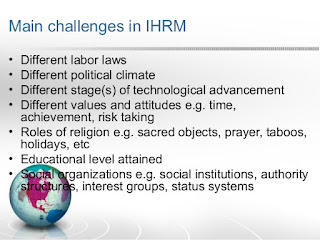International
HRM
International Human Resource Management
(IHRM) can be defined as a set of activities targeting human resource
management at the international level. It strives to meet organizational
objectives and achieve a competitive advantage over competitors at the national and
international levels.
Boxall, (1992) defined International Human Resource Management (IHRM) as ‘concerned
with the human resource problems of multinational firms in foreign subsidiaries
(such as expatriate management) or more broadly, with the unfolding HRM issues
that are associated with the various stages of the internationalization
process. International human resource management is the process of managing
people across international boundaries by multinational companies. It involves
the worldwide management of people, not just the management of expatriates (Armstrong, 2009) .
Challenges
faced by International HRM
·
Cross-culture issues.
·
Training and Development to a set of
people from different nations.
·
Remuneration and salary package.
·
Setting standard performance appraisal
to people from different cultures.
·
Managing international staffing.
As reported by Welfare
(2006), the main contrast between national and global HR practice is the need
to see the bigger picture: ‘The difference is the higher complexity and the
need for sensitivity to different cultures and different business environments.
Advantages of
International HRM
- Groups within the subsidiary can gain in status
- Groups within the subsidiary become more cohesive, fostering group identity
- IHRM takes place within a culture appropriate to the local workforce and customers
Disadvantages
of International HRM
- Tendency to become 'exclusive'.
- Loss of central control, higher administrative costs as HRM function is sent 'down the line
- Loss of organizational control and organizational identity
Globalization & HR:
Certain Uncertainty/ Source: www.youtube.com
Due to globalization
and the implementation of IHRM, the Srilankan economy and people receive more
advantages, for example, foreign investment is a significant driver of economic
development. The investments contribute and improve work ethics, discipline,
skills, and knowledge of workers. It is an important means of technology
transfer and transmission of best practices in management and often brings with
them international markets (Weerakkody, 2016) .
References
Armstrong, M. (2009). Armstrong's Handbook of Human
Resource Management Practice. London: Kogan Page.
Boxall, C. P. (1992). Strategic
human resource management: where have we come from and where should we be
going? UK.
Weerakkody, D. (2016,
November 04). Daily Mirror. Retrieved October 05, 2019, from Daily
Mirror:
http://www.dailymirror.lk/article/The-need-for-BOI-to-become-more-competitive--118657.html
Welfare, S (2006) A whole world out
there: managing global HR, IRS Employment Review, 862, 29 December
Soumya Sahoo (2012).
International hrm. [online] Available at:
https://www.slideshare.net/SoumyaSahoo1/international-hrm-15512350 [Accessed 21
Jun. 2020].
studyofwork (2014).
Globalization & HR: Certain Uncertainty. YouTube. Available at:
https://www.youtube.com/watch?v=kqr8r8r95x0 [Accessed 19 Oct. 2019].

















